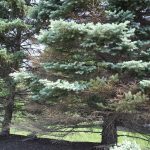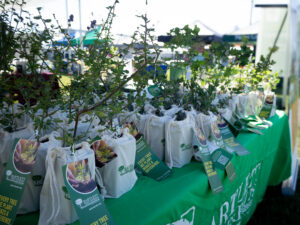The effects of the 2010 drought on Central Indiana’s evergreens this year
 You may have noticed an abnormal number of evergreen trees around the central Indiana area that are dying or browning excessively. With over 30 days of temperatures above 90 degrees Fahrenheit in 2010 (18 days more than normal for our area) and a moderate to severe drought during the same period (approximately 8” deficit for the period), many trees and shrubs either not well-suited for our region, or those in stressed or vulnerable conditions prior to the season, moved from stress to dieback, and in some cases, simply died. Many other healthy trees also experienced damage and have become stressed and vulnerable to a host of other problems as a result.
You may have noticed an abnormal number of evergreen trees around the central Indiana area that are dying or browning excessively. With over 30 days of temperatures above 90 degrees Fahrenheit in 2010 (18 days more than normal for our area) and a moderate to severe drought during the same period (approximately 8” deficit for the period), many trees and shrubs either not well-suited for our region, or those in stressed or vulnerable conditions prior to the season, moved from stress to dieback, and in some cases, simply died. Many other healthy trees also experienced damage and have become stressed and vulnerable to a host of other problems as a result.
We began seeing these failures as early as late last summer, and many symptoms are only manifesting now. The effects of drought can persist for years beyond the actual event.
 Direct physiological damages to plant tissues can range from foliar, root, and branch or stem tissue desiccation, and can lead to infection by disease pathogens, and insect or mite infestations in any of these affected areas. While some of these pests may be opportunistic and remain relatively minor in the grand scheme of plant health, this stress may be all that is needed for trees to enter a mortality spiral. We could liken the situation to an illness that compromises our own immune system, just before we contract a generally weak virus.
Direct physiological damages to plant tissues can range from foliar, root, and branch or stem tissue desiccation, and can lead to infection by disease pathogens, and insect or mite infestations in any of these affected areas. While some of these pests may be opportunistic and remain relatively minor in the grand scheme of plant health, this stress may be all that is needed for trees to enter a mortality spiral. We could liken the situation to an illness that compromises our own immune system, just before we contract a generally weak virus.
So, what can we do?
First, provided your landscape plants are important, you should retain an ISA-Certified Arborist to arrange for frequent monitoring of your trees and shrubs. Arborists look at trees with eyes trained by years of experience, education, and research. Arborists can almost always detect or forecast plant health issues long before the property owner ever sees the first symptom. And many times waiting until the owner sees the first symptom can be too late to stop a spiraling decline. Making the effort to promote healthy conditions through cultural, environmental, and nutritional means pays dividends over the long haul. Just ask any medical professional or athlete. Trees, themselves being living organisms, follow these same natural laws. But if you are already dealing with a current health problem, your arborist should be able to provide sound recommendations on a course of action. Some of these things are listed below.
Irrigation (most climates): Most large landscape trees require one inch of water per week during the growing season (spring to summer). The equation for clay and loam soils yields approximately 750 gallons of water per 1,000 square foot beneath the crown of the tree. New transplants, plants in sandy soil, and root-damaged trees should have water twice a week (split watering). Concentrate water on the root ball of new plantings. The use of drip irrigation systems or soaker hoses allows the most efficient method of irrigation, because they eliminate plants not to be irrigated. Adapted native plants can survive in their natural environment with very little moisture. In summer months, water nonadaptive mature trees and shrubs no more than once a week. If there has been no precipitation for 4-6 weeks in winter months, water deciduous and evergreens to keep the root zone moist. Young trees should be watered more often than older plants. After they become established (1-2 years), allow for a slight drought period between irrigating to encourage drought tolerance and structural integrity. Use of a soil probe will indicate when watering is necessary. If the soil is dry, it will be difficult to put a probe into the ground (more than 3-4 inches). Sufficiently moist soil will give easily. High water dependent plants like cottonwoods and willows need much more water than arid region species.
Mulch: Retaining soil moisture during drought conditions, mulch also adds organic material to the soil, promoting root development. Mulch also reduces the competition for water from weeds. Organic mulch — wood chips, shredded bark, bark nuggets, or pine straw — is recommended for mulching. Be sure to keep mulch away from the base of the plant!!! The root collar of all woody perennials should be readily visible, or you are breeding a problem!
Soil Management: Healthy trees start in healthy soils. Apply fertilizers based on current soil analyses when soil moisture levels have been replenished. The application of nutrients during drought conditions will have little effect on plant growth, because of the plant’s decreased ability to uptake water and nutrients. Agricultural fertilizers, or fertilizers with a high salt content, can actually intensify drought stress. It is also important to check bulk density levels when analyzing your soil. Clay soils are normally compacted at levels that inhibit or prevent root growth. If roots don’t grow, the source of nutrients to the crown is thereby limited. Compacted soils can be remediated, without damaging root systems, to improve root development.
IPM — Pest Management: Frequent monitoring or preventive care may be required for certain species as their host susceptibility dictates. Consult with a certified arborist for the best plan of monitoring and treatment.
Pruning: Crown cleaning eliminates dead and dying branches that may harbor insect borers or canker disease fungi that are contributing factors to further decline and dieback. Dense crowns could be lightly thinned to lessen demands for water and nutrients. The live canopy should not be excessively thinned because this will increase stress from defoliation and wounding.
Drought Resistant Plants: Use drought resistant plants in low maintenance landscape areas. These vary according to hardiness zone/geographical area.
Trees and shrubs add value to our landscapes and our lives. Like any other living organism, their survival is dependent on a balance of health and pressures. When pressures exceed resistance as determined by health or susceptibility, failure becomes imminent. We (humans), being the more highly designed organisms, bear the responsibility of stewardship for the lesser organisms, whether we accept it or not. While that does not necessarily mean we have to hug or even save every tree, it does imply that their contribution to our lives will only be as valuable as we help them to be. Here’s to making our world a more beautiful place to live!
Weather data from the National Climatic Data Center



